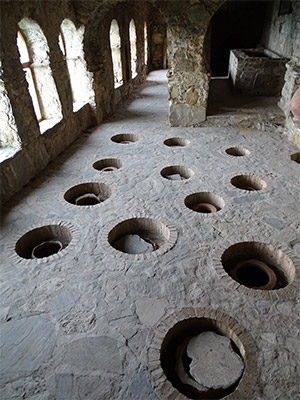That’s a long story. Marco Polo, Alexandre Dumas, and John Steinbeck wrote about Georgia’s distinctive wines. And way before that, the ancestors of modern-day Georgia were turning grapes into wine. Archaeologists have found traces of winemaking on 8,000-year-old pottery shards in Georgia, allowing the tiny republic to claim the crown of the world’s oldest wine producer.

Kvevri, the large earthenware vessels used for the fermentation,
storage and ageing of traditional Georgian wine.
Georgian wines are entering a period of rediscovery. Georgia has over 400 indigenous grape varieties but until recently, commercial production focused on only five or six grape types that could produce easily pleasing wines similar to Pinot Grigios or Cabernet Sauvignons. But now, winemakers are opting to plant more old varieties to create new styles. Look for grape types like Chkhaveri vinified into a pale red wine with strong spice notes and also used for a semisweet sparkling wine, Shavkapito, producing full-bodied wines with delicate aromatics, and Tsolikouri for full bodied whites with strong minerality.

Traditional Georgian Wine Cellar
© Adam Jones
© Adam Jones
Winemakers have revived the tradition of making wines in kvevri, large terracotta amphoras buried in the ground. Georgia’s hallmark white wines stay in contact with their skins for months and then further ferment in these kvevri. These traditional methods have converged with the renewed interest in all things artisanal; seen as a new trend in the West, these ‘orange wines’ have created a lot of buzz.
The rediscovery is not just within Georgia. Following the war with Russia in 2008, Georgia lost about 95% of its export market. Ever since then, the country’s winemakers have been working hard to diversify their target markets. In 2018 there were close to 1000 wineries in the country with wines exported to over 50 countries. Sales to Canada have increased by double digits.

© winesgeorgia.com
Georgian wines are continuing to improve with more attention to terroir, process, and education. Wineries such as Pheasant’s Tears and Lapati in the Kakheti wine heartland are leading new developments.

Wine and Khachapuri, a traditional Georgian dish of cheese-filled bread
Georgia’s songs, legends, and art all speak to a tremendous sense of pride in the country's wines. An ancient legend relates how soldiers wove a piece of grapevine into the chain mail protecting their chests, so that when they died in battle, a vine sprouted directly from their hearts.
If you’d like to taste these old new wines where they’re made, meet the winemakers, and find out how Georgian wines reflect the country's eccentric and fascinating culture, join us in Georgia in October, 2021.
*Quote from Lisa Granik in Club Oenologique.
Georgia & Armenia
October 10 - 23, 2022 | Learn more
October 10 - 23, 2022 | Learn more



